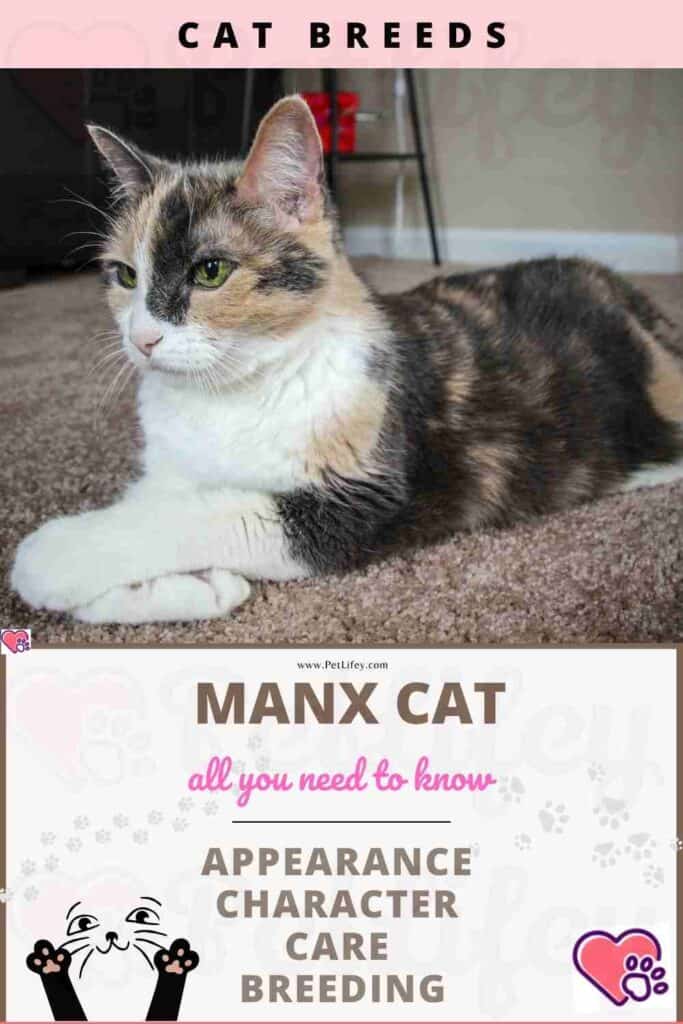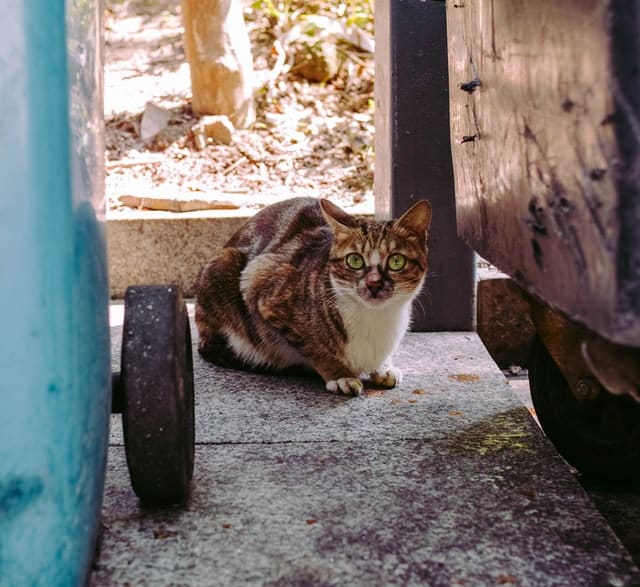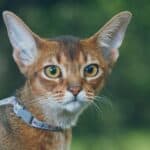
The Manx cat, affectionate and sociable, does not like to be alone. It’s master, if it is often absent, will have to find them a companion, but it does not have to be a cat because the Manx also appreciates dogs.
The origins of the Manx Cat

Originally from the Isle of Man, (halfway between England and Ireland) from which it took the name, this cat is the curious result of restricted crossings due to a fairly limited feline population; natural selection gave birth to this very peculiar cat, known to be without a tail, and in this case referred to as Manx Rumpy.
The Manx cat is not always without a tail, however, because we also find the Stumpy, which has a small end of it, the Riser, whose tail end can only be guessed by touch, and the Longy, with a real caudal appendage.
The existence of these other types of Manx is fortunate, because the genes that carry the anuria (the absence of a tail) are very dangerous for the survival of the kittens.
This is why, even if the exhibitions only receive subjects without a tail, in reality subjects are also raised which show some vestiges of it; this way you can cross them with a Rumpy, because Manx syndrome, which takes so many victims, only appears when you cross two specimens without a tail.
Appearance of the Manx Cat
In addition to the lack of a tail, roundness is another essential characteristic of the Manx cat . Everything is therefore round in this cat: the eyes, the head, the feet and the body; the ears, large and wide apart, rounded at the tip.
But that’s not enough: this cat, on the whole, has to be completely round. It is a large animal, compact and muscular, with deep sides; the back is short and forms a flexible arch between the shoulders and buttocks, which are higher.
The Manx has another peculiarity, which manifests itself in the hind legs clearly longer than the front ones; Not only does this make it look like a big bunny, but it also allows it to make amazing leaps and have tremendous acceleration capability.
His coat, which appears shiny and dense, very soft, has a supplied undercoat, with longer dominant hairs; this is what counts because the length of the hair does not matter; indeed, in addition to the mid-length, there is also a long-haired variety called Cymric.
Coat color of the Manx Cat
All colors and designs of the dress are all accepted, except those that carry the Siamese gene, i.e. all colourpoints. The most common are red, black, blue and white.
The character of the Manx Cat
The Manx cat is such a loving and devoted cat, such a great companion for the whole family, from children to the elderly, that Americans call it dog like. It is balanced and very intelligent, It loves to feel loved and, precisely to gain the affection and the approval of its master, it learns everything you want to teach them.
Love for its master leads them to take protective attitudes. It is a real “watch cat” which blows and even attacks strangers who have the misfortune to arouse its suspicion.
With them, you have to be very careful because it not only learns what not to do, like climbing curtains or scratching armchairs, but also everything that humans do, like opening doors. – from the house, from the refrigerator – and even the taps.
Hug:
Naturally affectionate, it is kindness embodied.
Player:
Excellent hunter, no wonder he loves to play! This feline will appreciate the daily play sessions where it can exercise its talents.
Calm:
Despite everything, the one we also call Manks knows how to be calm, proof that it adapts easily.
Intelligent:
Very intelligent, it is said that it can learn feats almost effortlessly … such as opening doors and faucets.
Fearful / suspicious of strangers:
It will have a slight tendency to take its time a little more before fully trusting a newcomer. Respect and understanding are essential.
Independent:
It prefers the presence of its humans, or sometimes four-legged companions, rather than solitude.
Behavior of the Manx Cat
Talkative : Little meowth, the Manx prefers to coo.
Greedy / gluttonous:
With a good appetite, this tomcat is a little gluttonous, which contributes to making them gain weight easily.
Need for exercise:
If its energy level is moderate, its physique of a rabbit with powerful hind legs makes them a prodigious jumper and allows them an excellent capacity for acceleration. And it will not hesitate to use these talents.
Runaway:
It would usually be too attached to its human to run away, but there will always be exceptions.
Compatibility of the Manx Cat
The Manx with the Dogs:
Presented to each other correctly, a beautiful bond can be born between a Manx and a dog.
The Manx with other cats:
Sociable, our tailless cat will know how to adapt to other feline companions, if given the time and the possibility, of course.
The Manx with Children:
With light supervision, this big whiskered teddy bear will be patient with children.
The Manx with the Elderly:
By making sure it has just enough exercise time, it can be the perfect companion for a calm and discreet person, even more so if they give them a lot of attention.
Price of the Manx Cat
A Manx cat can cost between 500 USD and 1300 USD , depending on the age, sex, type, lineage… You will have to spend around 35.60 USD per month for the care of this cat.
Maintenance of the Manx Cat
Grooming:
Regular brushing, from time to time, is sufficient. During the moulting period, it may need to be brushed a little more often to remove the dead hairs.
Hair Loss:
Despite its coat and thick, dense undercoat, he loses very reasonably.
Food of the Manx Cat
Particular attention must be paid to its diet, in order to prevent them from gaining too much weight. They will thus be offered good quality food, in croquettes and or pate, without excess and served in an interactive bowl.
Caring of the Manx Cat
If it is not affected by Manx syndrome – and in this case it hardly exceeds the first months of its life – it is a very healthy, very robust cat, which does not require special care (apart from the usual grooming).
One of its pleasant characteristics is its exceptional longevity: if it is well treated, it can easily reach the age of twenty, without any particular disturbances peculiar to its great age; this may be due to the slowness of its maturity, the Manx cat not really becoming an adult until around the age of three.
Health of the Manx Cat
Life expectancy:
Long to reach maturity, it can also break records for longevity, with an average of about fifteen years.
Resistant / Robust:
Even if one might think the opposite, the “tailless cat” is rather robust.
Tendency to gain
weight : This tomcat has a certain genetic predisposition to being overweight.
Frequent diseases:
Manx Syndrome: when the mutated gene shortens the spine too much, severe abnormalities appear in the spine and spinal cord, such as a form of spina bifida, but also in the bladder, intestines, hind limbs… The life expectancy of these unfortunates is very shortened, the record being 5 years
Megacolon : often of nervous origin, the colon is no longer able to contract in order to be able to eliminate stools. It may or may not be part of Manx Syndrome
Intertrigo : infection in the folds of the skin
Corneal dystrophy : malformation of the eye
The Manx can also be called upon to develop the same pathologies found in any other cat without a pedigree. It can also present a certain fragility to periodontal disease ( gingivitis and tartar). Prevention and dental care will be recommended.
Reproduction:
The Manx (M) gene, a dominant gene, is expressed when it is present. However, all tailless cats have only one mutated gene, with the other allele encoding a full tail length (m). They say they are [Mm].
When the mutated gene is completely absent [mm], the tail is just normal. In contrast, a [MM] kitten will have so many changes in its spine and spinal cord that it will not survive. The gene is therefore lethal, which makes breeding the breed rather difficult.
In breeding Manx cats, it is important never to mate two cats completely without a tail, because the risk of obtaining kittens with Manx Syndrome is very high (30% risk of being affected). We prefer to couple a Rumpy with a Stumpy or a Longy.
Good to know
The absence of a tail requires special attention when handling this cat. With the terminal caudal nerve endings still present, exerting pressure where the tail should be could cause pain to the cat. Likewise, to avoid tension in the spine, you will have to remember to support your hindquarters when lifting it.
On the other hand, whether it has a tail or not, this skillful jumper will never lack balance since the tail has no influence on this ability.






